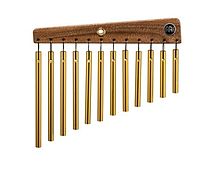Mark Tree
Mark Tree (English), also chime tree, wind chimes or bar chimes , is a percussion instrument that consists of a number of metal bars of different lengths (usually less than 25 cm). These are suspended close to each other on a support and are struck with a mallet or fingernails in one go to achieve an "introductory" sound effect from the highest to the lowest rod (also vice versa). The actual tone is created by striking the neighboring metal rods together. They create a descending sound similar to the glissando of a harp, the strings of which are passed from top to bottom, but with a metallic timbre.
There are also mark trees made of wood, bamboo, shells or glass, which are then named accordingly. Tubular bells are also referred to as "chimes" in English , so the instrument should either always be referred to as a mark tree or, alternatively, when using the term "chimes", the complete designation ( chime tree or wind or bar chimes ) should be added, to avoid confusion.
The Mark Tree was invented by studio percussionist Mark Stevens in the late 1960s and is named after him.
The Mark Tree is mainly used in musicals, jazz and pop ballads, but also in orchestral film music of the 20th and 21st centuries (often e.g. at Disney). The metallic sound of the instrument is often used to represent a “magical” or “magical” sound impression. However, the Mark Tree does not have to serve exclusively to represent sound figures, but also often for more gentle transitions (similar to a basin), or as a diminutive musical element. One of many examples can be in the rap / R & B song Wild Wild West of Will Smith find.
literature
- Kalani: All about Hand Percussion: Everything You Need to Know to Start Playing Now! Alfred Music Publishing, 2008, p. 24, ISBN 978-0-7390-4964-8 ( limited preview in Google book search)
